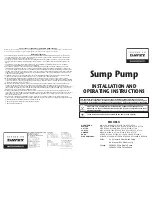
Page 50 of 52
15.
APPENDIX V – Accessories
15.1
PULSAtrol Pulsation Dampener
The PULSAtrol is a pneumatically charged diaphragm-type chamber that intermittently stores
energy. Used on the inlet, it will improve NPIPA (Net Positive Inlet Pressure available)
characteristics of the suction piping system. On the discharge line it will reduce peak pressures
and pulsating flow variations.
Installation
On both discharge and suction lines, it is desirable to mount the PULSAtrol as close to the pump
connection as possible. It can be mounted in any position: horizontally, vertically, or at any angle.
A shutoff valve should always be used between the piping system and PULSAtrol. If the discharge
line is open to atmospheric pressure, a backpressure valve should also be incorporated in the
system near the PULSAtrol to assure proper operation. Pulsation dampeners do require regular
maintenance and inspection. Charge pressure should be checked every 2 – 4 months and
renewed as needed. Temperature, pressure, and other variables will affect charge life and
diaphragm/bladder life.
Discharge Setup
The PULSAtrol may be pre-charged with air or nitrogen. When properly pre-charged the
diaphragm is positioned against the bottom liquid chamber. It is therefore necessary to drain all
liquid below the diaphragm and vent to atmospheric pressure when pre-charging.
Use the pre-charge pressure as determined from the PULSAtrol selection and sizing procedure.
This can vary from 50 to 80% of mean line pressure in accordance with fluctuation level selected.
The PULSAtrol is now ready for service and the diaphragm will move to a neutral position as liquid
enters the chamber.
Pre-Charge Procedure for Discharge Installation
1. Calculate the pre-charge pressure
a. Mean line pressure (psig) + Atmospheric Pressure = Absolute Pressure (psia)
b. Absolute Pressure (psia) x Pre-charge percentage (80% max) = Pressure Absolute
c. Pressure Absolute – Atmospheric Pressure = Pre-charge Pressure (psig)
2. Isolate PULSAtrol from line
3. Carefully drain off process fluid by open a drain valve
4. Apply pre-charge pressure (additional liquid may drain as diaphragm moves)
5. Close drain valve
6. Place PULSAtrol in stream
Suction Setup (Flooded Suction)
Charge the PULSAtrol with adequate pressure to overcome the static suction head. Start up the
pump. Depress the stem on the charge valve, but only during discharge strokes of the pump, until
the gauge indicates pressure pulses. The diaphragm has now centered allowing the PULSAtrol to
accumulate liquid while the pump is discharging. If too much air becomes released and the gauge
will not indicate pressure pulses, recharge the PULSAtrol and repeat the procedure.
Pre-Charge Procedure for Suction Installation
1. Isolate accumulator from line
2. Carefully drain off process fluid by opening a drain valve
3. Apply 5 – 10 psi pre-charge pressure (additional liquid may drain as diaphragm moves)
4. Close drain valve
5. Bleed off all pressure on the PULSAtrol
6. Open the valve to put PULSAtrol in stream
7. Push in on the stem of the charging valve during the discharge stroke of the pump and release
during the suction stroke
8. Continue this for about ten times and observe the compound gauge. As accumulator functions,
the needle will go from pressure to vacuum



































